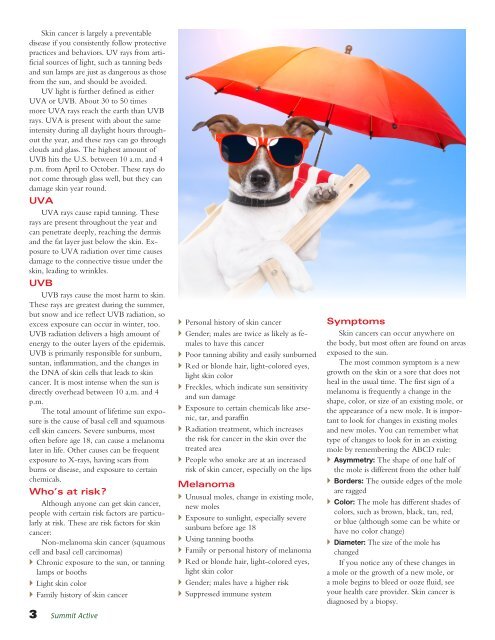active - Summit Healthcare
active - Summit Healthcare
active - Summit Healthcare
Create successful ePaper yourself
Turn your PDF publications into a flip-book with our unique Google optimized e-Paper software.
Skin cancer is largely a preventable<br />
disease if you consistently follow protective<br />
practices and behaviors. UV rays from artificial<br />
sources of light, such as tanning beds<br />
and sun lamps are just as dangerous as those<br />
from the sun, and should be avoided.<br />
UV light is further defined as either<br />
UVA or UVB. About 30 to 50 times<br />
more UVA rays reach the earth than UVB<br />
rays. UVA is present with about the same<br />
intensity during all daylight hours throughout<br />
the year, and these rays can go through<br />
clouds and glass. The highest amount of<br />
UVB hits the U.S. between 10 a.m. and 4<br />
p.m. from April to October. These rays do<br />
not come through glass well, but they can<br />
damage skin year round.<br />
UVA<br />
UVA rays cause rapid tanning. These<br />
rays are present throughout the year and<br />
can penetrate deeply, reaching the dermis<br />
and the fat layer just below the skin. Exposure<br />
to UVA radiation over time causes<br />
damage to the connective tissue under the<br />
skin, leading to wrinkles.<br />
UVB<br />
UVB rays cause the most harm to skin.<br />
These rays are greatest during the summer,<br />
but snow and ice reflect UVB radiation, so<br />
excess exposure can occur in winter, too.<br />
UVB radiation delivers a high amount of<br />
energy to the outer layers of the epidermis.<br />
UVB is primarily responsible for sunburn,<br />
suntan, inflammation, and the changes in<br />
the DNA of skin cells that leads to skin<br />
cancer. It is most intense when the sun is<br />
directly overhead between 10 a.m. and 4<br />
p.m.<br />
The total amount of lifetime sun exposure<br />
is the cause of basal cell and squamous<br />
cell skin cancers. Severe sunburns, most<br />
often before age 18, can cause a melanoma<br />
later in life. Other causes can be frequent<br />
exposure to X-rays, having scars from<br />
burns or disease, and exposure to certain<br />
chemicals.<br />
Who’s at risk?<br />
Although anyone can get skin cancer,<br />
people with certain risk factors are particularly<br />
at risk. These are risk factors for skin<br />
cancer:<br />
Non-melanoma skin cancer (squamous<br />
cell and basal cell carcinomas)<br />
Chronic exposure to the sun, or tanning<br />
lamps or booths<br />
Light skin color<br />
Family history of skin cancer<br />
3 <strong>Summit</strong> Senior Active Wellness<br />
Personal history of skin cancer<br />
Gender; males are twice as likely as females<br />
to have this cancer<br />
Poor tanning ability and easily sunburned<br />
Red or blonde hair, light-colored eyes,<br />
light skin color<br />
Freckles, which indicate sun sensitivity<br />
and sun damage<br />
Exposure to certain chemicals like arsenic,<br />
tar, and paraffin<br />
Radiation treatment, which increases<br />
the risk for cancer in the skin over the<br />
treated area<br />
People who smoke are at an increased<br />
risk of skin cancer, especially on the lips<br />
Melanoma<br />
Unusual moles, change in existing mole,<br />
new moles<br />
Exposure to sunlight, especially severe<br />
sunburn before age 18<br />
Using tanning booths<br />
Family or personal history of melanoma<br />
Red or blonde hair, light-colored eyes,<br />
light skin color<br />
Gender; males have a higher risk<br />
Suppressed immune system<br />
Symptoms<br />
Skin cancers can occur anywhere on<br />
the body, but most often are found on areas<br />
exposed to the sun.<br />
The most common symptom is a new<br />
growth on the skin or a sore that does not<br />
heal in the usual time. The first sign of a<br />
melanoma is frequently a change in the<br />
shape, color, or size of an existing mole, or<br />
the appearance of a new mole. It is important<br />
to look for changes in existing moles<br />
and new moles. You can remember what<br />
type of changes to look for in an existing<br />
mole by remembering the ABCD rule:<br />
Asymmetry: The shape of one half of<br />
the mole is different from the other half<br />
Borders: The outside edges of the mole<br />
are ragged<br />
Color: The mole has different shades of<br />
colors, such as brown, black, tan, red,<br />
or blue (although some can be white or<br />
have no color change)<br />
Diameter: The size of the mole has<br />
changed<br />
If you notice any of these changes in<br />
a mole or the growth of a new mole, or<br />
a mole begins to bleed or ooze fluid, see<br />
your health care provider. Skin cancer is<br />
diagnosed by a biopsy.






